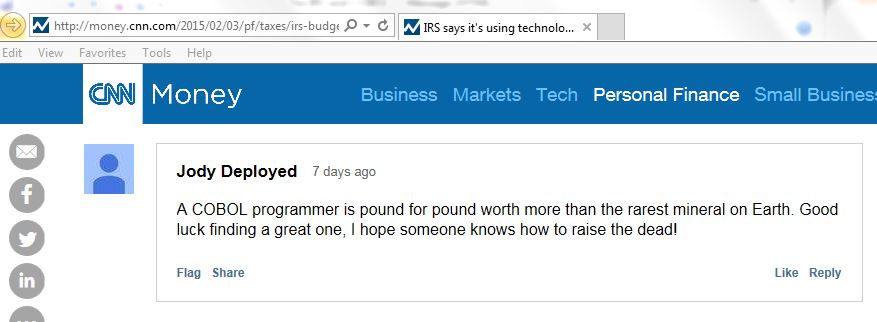When I read blogs and articles discussing COBOL and then scroll through the negative comments underneath, my first thought is to write a post to continue to defend COBOL and disprove all of the negativity. But that is not where I ended up today.
I am at point in my career where I hope to be able to bring programming value for another 10 – 15 years. I have learned in recent years to develop applications in Visual Basic, .NET, C# as well as continued development and maintenance of COBOL applications. It was 34 years ago that I was taught the COBOL programming language but my appreciation of what COBOL could offer in an organization did not happen immediately in my first job after college.
My first job after college took me through computer operations where I was a night computer operator on a Digital VAX mainframe for over a year. It was in this position that I began to see the huge benefits of COBOL in a BATCH processing environment. The speed of COBOL handling thousands and thousands of transactions and the detailed reports being produced was amazing to me! I was then mentored by one of the COBOL programmers for about 4 months in COBOL programming techniques and was given some smaller projects that I could work on while doing my nightly operations. I was able to get up to speed very quickly and began to maintain and develop some COBOL programs.
So, with that being said, I can truly understand why someone that has never seen or worked with COBOL may not appreciate the history and current day value that COBOL can and does bring to the table.
As you see from my history, it took me awhile to really gain that knowledge and appreciation of COBOL even though I had already spent a huge chunk of time at the University, in the computer room, learning and writing COBOL.
So why continue the arguments? I’ve arrived at a place where I feel that there’s no need to. Detlef a.k.a “The COBOL Kid” and I are going to go into some deep discussions over the next weeks to explore and hopefully shed some light and understanding on the need for COBOL in 2015.
Recently, I found this comment in the string following a blog post discussing IRS budget cuts and COBOL.
Good one!
I recently was asked by a college student if I could teach him COBOL. It wasn’t that he wanted to be a true professional COBOL’er but it was the fact that he read these Blogs and magazine articles at a deeper level (without formulating an immediate opinion) and realized that there is going to be a need for COBOL programmers in the near future and maybe he could step into the picture somewhat with some basic training. He understood the language and opinion that the experienced programmers were sharing. And this brought me full circle. It may not be as much about raising the dead (although this fits perfectly with COBOLZombies), but maybe we are being directed towards a need to begin sooner than later the necessary training and mentoring today’s and tomorrow’s pool of programmers.






 I am wondering how one can help here. Myself I am writing in this ‘un-cool’ and ‘dead’ language since 25+ years. Using the Micro Focus Workbench I started writing Mainframe emulators. A complete Toolset to migrate files, run Batch processes and Emulating a whole Transactional System, all written in this ‘un-cool’ Language. How can we make students understand that COBOL is not dead? How can we make Teachers understanding that they have to teach even so called ‘dead’ languages? Let’s start the Discussion! You, yes you, who just read it, play the Ball. Let’s talk. Wants to read the full Article? Here you go.
I am wondering how one can help here. Myself I am writing in this ‘un-cool’ and ‘dead’ language since 25+ years. Using the Micro Focus Workbench I started writing Mainframe emulators. A complete Toolset to migrate files, run Batch processes and Emulating a whole Transactional System, all written in this ‘un-cool’ Language. How can we make students understand that COBOL is not dead? How can we make Teachers understanding that they have to teach even so called ‘dead’ languages? Let’s start the Discussion! You, yes you, who just read it, play the Ball. Let’s talk. Wants to read the full Article? Here you go.
